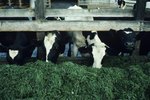Things You'll Need
Scissors or knife
String
Styptic powder
Mineral blocks
Warnings
Never treat a medical condition without the advice of your veterinarian. You might think you are saving yourself time and money by treating your cattle without guidance, but you could end up causing more harm than good.
Tips
Be gentle when handling your cattle. Catching and treating animals can be frightening for cattle that have never been handled, so try to minimize the stress by moving carefully and handling your cattle with care.
Cattle warts are a chronic condition affecting millions of cattle worldwide. Caused by the papillomatomavirus, the warts appear mainly on the heads and necks of cattle under 2 years old. The papillomatomavirus enters the skin through a lesion or abrasion and takes anywhere from one to 12 months to manifest as warts. While cattle warts rarely cause serious health problems, they are unsightly and can lower the value of market animals. Treating cattle warts can take a little time, but it is well worth it for the health and well being of your animals.
How to Cure Cattle Warts
Schedule an appointment with your vet to have the warts examined. Your vet may pull or cut the warts off, depending on their size, and can recommend an appropriate course of treatment for your cattle. Ask your vet any questions you may have about treating the warts yourself to avoid injuring any of your cattle once you get home.
Purchase a papillomatomavirus vaccine from your veterinarian or through an animal supply catalog. The vaccine is made with a variation of the actual virus, which helps your cattle build immunity to the warts. Inject your calves with 10 mL of the vaccine in two different spots along the neck for optimal results. Up the dose to 15 mL for older cattle and repeat in three to five weeks to fully control the warts outbreak.
Apply a topical wart remover if your cattle have only a few warts. A commercially available wart remover designed for livestock can be purchased at most vets' offices and feed stores. You can also use a product designed for humans, such as a freeze-off treatment, if you are trying to remove the warts quickly in show cattle.
Trim off any small warts as shown by your vet. Tie the wart off as close to the skin as possible with sterile cotton thread, tying the string tightly to act as a tourniquet. Cut the wart off directly above the string, taking care to remove it as quickly as possible to minimize discomfort. Cover the area in a thin layer of styptic power, which will help stop the bleeding.
Feed your cattle a diet rich in minerals to help minimize wart outbreaks. Cattle with a diet rich in a variety of minerals such as calcium, phosphorous and sulfur tend to have fewer wart outbreaks than cattle lacking proper minerals. Make sure your cattle have free access to mineral blocks at all time.
References
Tips
- Be gentle when handling your cattle. Catching and treating animals can be frightening for cattle that have never been handled, so try to minimize the stress by moving carefully and handling your cattle with care.
Warnings
- Never treat a medical condition without the advice of your veterinarian. You might think you are saving yourself time and money by treating your cattle without guidance, but you could end up causing more harm than good.
Writer Bio
Louise Lawson has been a published author and editor for more than 10 years. Lawson specializes in pet and food-related articles, utilizing her 15 years as a sous chef and as a dog breeder, handler and trainer to produce pieces for online and print publications.




